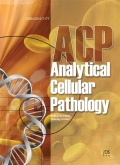Authors: Soreide, Kjetil | Buter, Tirza C.E. | Janssen, Emiel A. | Gudlaugsson, Einar | Skaland, Ivar | Körner, Hartwig | Baak, Jan P.A.
Article Type:
Research Article
Abstract:
Background and aims: Although adenomas may be precursors to colorectal cancers (CRC), knowledge concerning the development of metachronous CRC is scarce. We assessed whether differential expression of cell-cycle and apoptosis-regulating proteins and a monotonous population of elongated cells (MPECs) in colorectal adenomas could predict metachronous CRC. Methods: Application of immunohistochemistry on tissue microarrays in consecutive, population-based colorectal adenomas. Influence of classic features (e.g., intraepithelial neoplasia grade, histological type, size) was examined. Results: Of 171 patients with colorectal adenoma 86% (n=147) were eligible for study; 10 (7%) developed metachronous CRC. Median time to cancer was 69 months (range, 25–256). Median follow-up
…was equal for the non-cancer and cancer groups. Elevated expression of cell-cycle regulators p16INK4A , p21CIP1 , and cytoplasmic/nuclear β-catenin correlated with increased CRC risk (all P<0.0001), as did elevated expression of the anti-apoptosis protein survivin (P<0.0001) and human telomerase reverse transcriptase (hTERT; P<0.001). Survivin, hTERT, and nuclear β-catenin were the most predictive molecular markers (hazard ratios [HRs]: 6.3, 9.4, and 5.8, respectively). In a combined multivariate model, MPECs had the best overall prognostic ability (HR 28.2, 95% CI: 3.6–223.0), together with survivin, and hTERT. Within adenomas containing MPECs, several molecular markers further defined high-risk patients. Conclusions: Among several markers predictive for metachronous CRC development in colorectal adenomas, MPECs, survivin and hTERT may, when validated, provide information superior to conventional histology, with relevance for the clinical management of patients with colorectal adenoma.
Show more
Keywords: Colorectal, adenoma, immunohistochemistry, cell cycle, apoptosis, metachronous cancer, molecular marker, diagnosis
Citation: Analytical Cellular Pathology,
vol. 29, no. 4, pp. 301-313, 2007
Price: EUR 27.50





